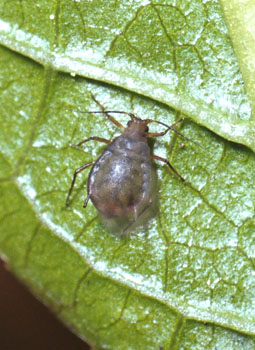Pests
Rhopalosiphum padi Linnaeus - Bird Cherry Oat Aphid.
Systematic position.
Class Insecta, order Homoptera, suborder Aphidinea, superfamily Aphidoidea, family Aphididae, subfamily Aphidinae, tribe Aphidini, subtribe Rhopalosiphina, genus Rhopalosiphum.Biological group.
Oligophagous pests.Morphology and biology.
The body of apterous female is gray-green with rusty-red spots around and between siphunculi. The body length varies from 2.7 to 2.9 mm. There are small marginal tubercles on prothorax and on abdominal segments I and VII. The antenna is more than half as long as body. Siphunculi cylindrical, slightly swollen at apex, longer than finger-like tail. Medial vein on front wing has two branches. The aphid life cycle includes two host plants. The first host is the bird cherry tree (Padus racemosa) or plum-tree (Prunus domestica) in West Siberia. Over-wintering takes place during the egg phase on buds of bird cherry trees. The sexual agamic generations are present during the aphid life cycle. In the zone of strong harmfulness the hatching of fundatrices larvae is observed in April. The larvae form colonies on upper side of leaves and on blossoms (there are 3 to 5 generations here). The branches are bent; the leaves turn yellow and twist. The larval period lasts 5-21 days, depending on environmental conditions. Life span of apterous parthenogenetic females is about 15-19 days at the temperature of 21╓C. Its fecundity reaches up to 70 larvae. At the end of May and beginning of June the aphids migrate from the first host to cereals. The pest feed on winter cereals at first and then on spring corn, on upper side of leaves and on ears. By the second or third of August the insects (winged males and viginoparae) migrate from summer reservations to bird cherry trees. The viginoparae are observed here, giving birth to females and males. The fecundation takes place, and then the eggs are laid in bud axils on young branches of bird cherry trees.Distribution.
The insect is widespread in Europe and Asia. Within the territory of the Former Soviet Union the species occurs widely northward to Khibiny in the European part, in Kazakhstan, Middle Asia, Siberia, Primorskii Territory, and Transcaucasia. Its high harmful activity appears in forest and forest-steppe zones.Ecology.
In the zone of strong harmfulness the maximum aphid numbers are observed in June (the plants being at the phase of stem elongation and tillering). The number of aphids decreases quickly at the end of June and the beginning of July. The most favorable conditions for apterous females are at temperatures of 21-25°C and relative humidity 70%. The appearance of sexual generation depends on the temperature and photoperiod. The minimum effective temperature for aphid development is 4-5° C, and for aphid flying: 9-10° C.Economic significance.
The pest causes the greatest damage to summer and winter wheat, summer and winter barley, rye, oats, sorghum, millet, rice. The insect feeds also on wild cereal grasses. Control measures include: forecasting pest appearance and number, eradication of weeds, insecticide treatments at the end of May and in June. Insect population may depend on activity of entomophages. Most important predators are insects of the families Coccinellidae (Coccinella septempunctata L., C. notata Host., C. axiridis Pall., and also representatives of the genera Adalia, Semiadalia, Adonia etc.), Syrphidae (the genera Syrphus, Melanostoma, Scaeva, Eupeodes, Paragus), Chrysopidae (C. carnea Steph., C. formosa Br.). Most important parasites are representatives of the family Braconidae (the genera Aphidius, Lysiphlebus, Ephedrus).Reference citations:
Bozhko M.P. 1950. On the fauna of aphids of Kharkov and Sumy Regions. In: Bulankin I.N., ed. Proceedings of Biological Research Insitute of Khar.kov State University, V. 14-15. Kharkov. 184-187 p. (In Russian)
Ivanovskaya O.I. 1977. Aphids of West Siberia. Part II. Novosibirsk: Nauka. 34-35 pp. (In Russian)
Ivanovskaya O.I., Krupyanskaya A.N. 1979. The aphids (Homoptera, Aphididae) damaging trees and bushes in Primorskii Territory. In: Ivliev L.A., ed. Ecology and biology of arthropods in the southern Far East. Vladivostok: Izd. AN SSSR. 44 p. (In Russian)
Kann A.A., Ibraimova K.I., Yukhnevich L.A. 1976. The cereal aphids and its distribution in Middle Asia and Kazakhstan. In: Protsenko A.I., ed. Entomological researches in Kirghizia, 11. Frunze: Ilim. 45 p. (In Russian)
Mamontova V.A. 1953. The aphids on agricultural crops of right bank forest-steppe zone of Ukraine. In: Belanovskii I.D., ed. Trudy instituta zoologii AN USSR. Kiev: Izd. ANUSSR. 62-63 p. (In Russian)
Radchenko E.E. 1991. The study of resistance of grain cultures to aphids (Methodical recommendations). Saint Petersburg: VIZR. 4-5 pp. (In Russian)
Shaposhnikov G.H. 1964. Suborder Aphidinea-aphids. In: Bei-Bienko G.Ja, ed. Keys to the insects on the European part of the USSR. Moscow & Leningrad: Nauka. V. 1: 489-616. (In Russian)
Vasil.ev V.P., ed. 1973. The pests of agricultural crops and forest plantations. Kiev: Urozhai. V. 1: 274-275. (In Russian)


